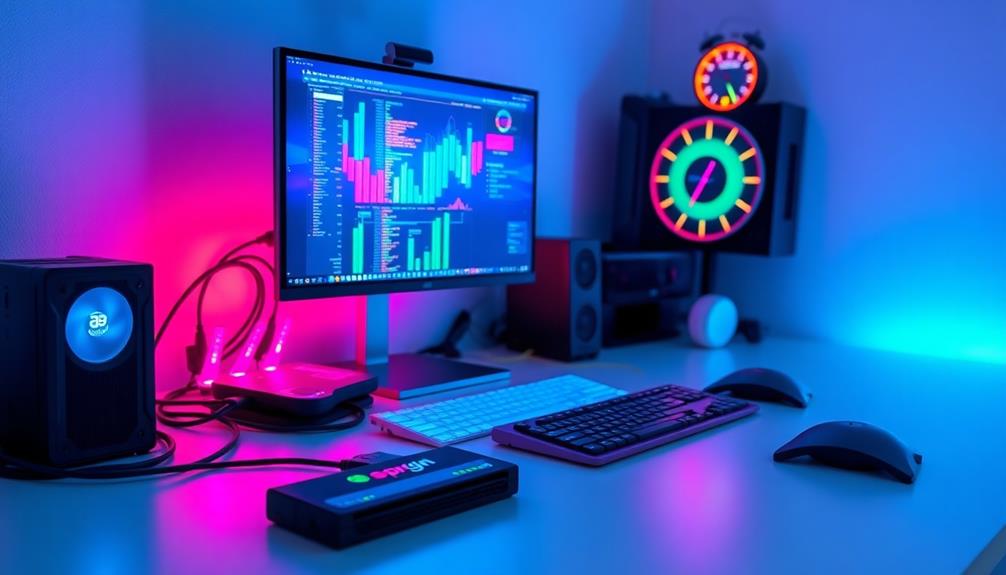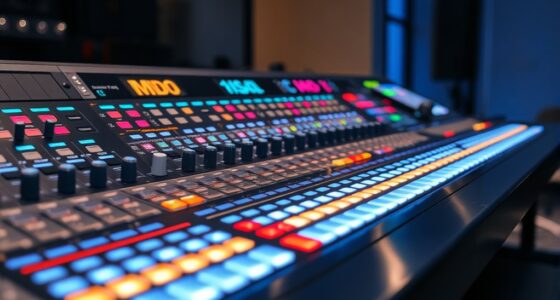To stream samples at lightning speed, you need to organize your SSD effectively. Start by creating a clear folder structure, grouping samples by type, like drums or synths. Limit subfolders to enhance retrieval speed, and always maintain consistent naming conventions. Keep at least 10-15% of your SSD capacity free for peak performance. Consider using high-speed NVMe drives for larger libraries and remember to periodically clean up unused files. With these tips, you can reduce load times and boost creativity. Stick around, and you'll discover even more strategies to enhance your audio production setup.
Key Takeaways
- Create a clear folder structure to group samples by type for quick access and improved organization.
- Implement consistent naming conventions to enhance file identification and reduce search time.
- Limit subfolder depth to streamline retrieval, ensuring files are accessible within three clicks.
- Regularly clean up unused files and maintain SSD space to optimize loading performance.
- Store frequently used samples in a dedicated favorites folder for instant access during production.
Importance of SSDs in Music Production
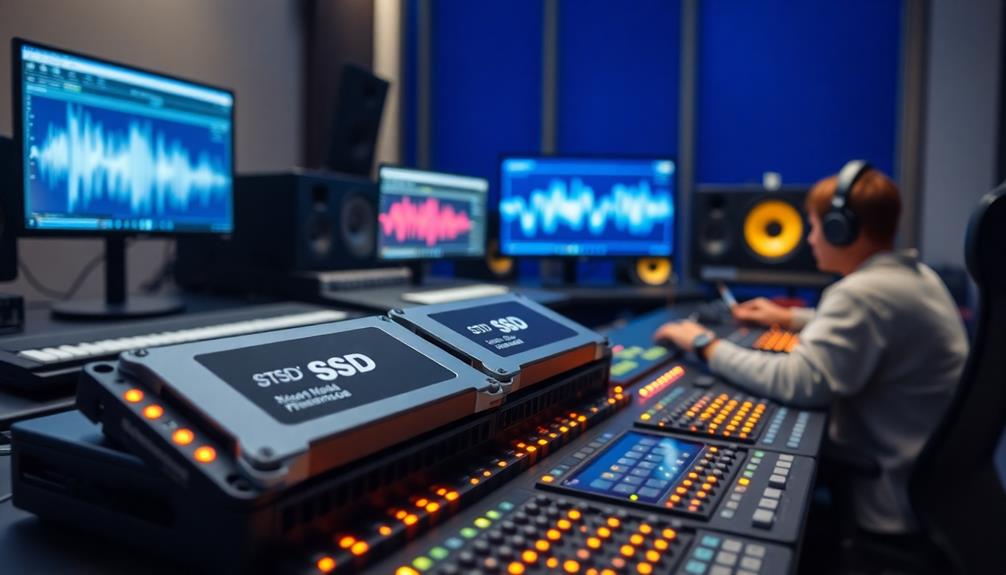
In today's fast-paced music production landscape, SSDs are game-changers. They greatly enhance your audio production workflows by providing faster load times for large orchestral sample libraries, which is vital in modern environments.
With SSDs, you can access your samples almost instantly, allowing you to focus on creativity rather than waiting around for files to load. Additionally, as highlighted in music education's rich landscape, integrating technology effectively can lead to more innovative practices in music creation.
The random access times of SSDs improve your ability to handle complex arrangements, enabling more simultaneous sample voices with lower latency. This means you can record or play back intricate pieces without hiccups. If you're using M.2 NVMe drives, you can achieve read speeds exceeding 3,200 Mbps, greatly outperforming traditional SATA SSDs and making sample streaming a breeze.
To maintain ideal performance, keep your SSDs under 85-90% capacity. This guarantees your audio projects load smoothly without lag or bottlenecks.
Regularly monitoring and organizing your SSD storage is equally important; it helps prevent data loss and guarantees quick access to essential samples. By prioritizing SSDs in your setup, you're setting yourself up for a streamlined production process that boosts your creativity and efficiency.
Types of SSDs for Sample Libraries

Choosing the right type of SSD for your sample libraries can greatly affect your music production experience.
With various options available, you'll want to select the one that best fits your needs and budget. Here are the main types of SSDs to evaluate:
- SATA SSDs: Affordable and suitable for many audio applications, with speeds around 500 MB/sec.
- NVMe drives: These excel in sample loading, offering speeds that can exceed 3,200 MB/sec, making them ideal for large, complex libraries.
- M.2 format SSDs: These provide remarkably faster read and write speeds compared to traditional SATA drives, perfect for high-performance audio workloads.
- Thunderbolt 3 SSDs: Future-proof your setup with these, as they can deliver speeds up to 40 Gbps, accommodating advances in technology.
When selecting your SSD, evaluate your workload type.
If you're working with orchestral libraries or large sample collections, NVMe drives are the way to go.
They'll guarantee you experience quicker load times and reduced latency, enhancing your overall workflow.
Effective SSD Organization Techniques
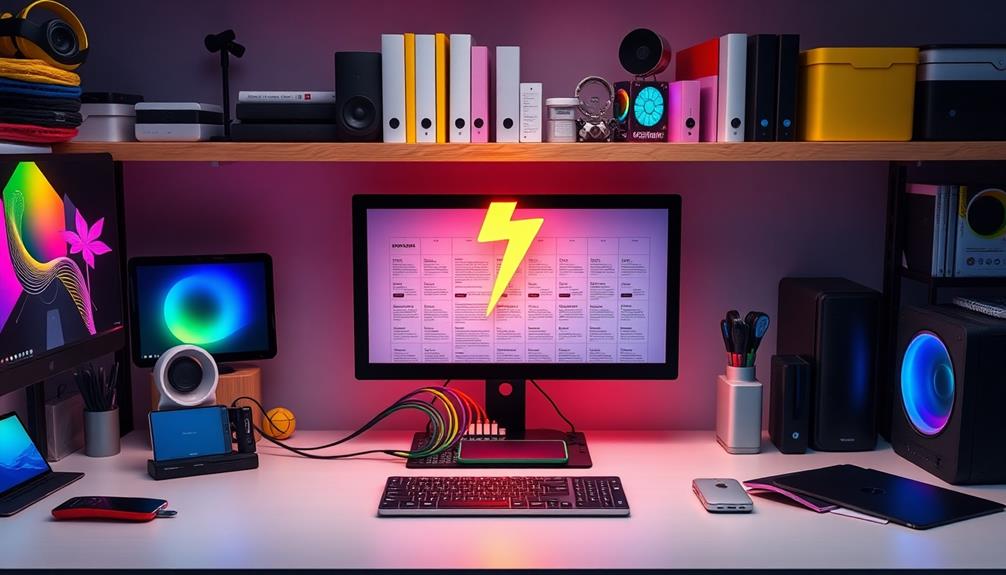
To keep your SSD organized, start by creating a clear folder structure that groups your samples by type, like drums or synths.
Implement a consistent naming convention to make it easier for you to find what you need quickly.
Additionally, consider utilizing actionable tips and strategies to streamline your organization process.
Folder Structure Optimization
A well-structured folder system is crucial for maximizing your SSD's efficiency and accessibility. To boost your SSD speed and streamline your workflow, follow these effective folder structure enhancement techniques:
- Limit Subfolders: Keep the number of subfolders to a minimum. This helps in quick sample retrieval and guarantees thorough categorization. Proper organization can prevent unnecessary clutter, much like maintaining your air purifier for peak performance.
- Organize by Category: Sort samples by company, pack name, or type (e.g., drums, vocals, FX). This familiarity makes navigation faster and easier on your SSD.
- Apply the 3 Click Rule: Design your folder structure so you can access any sample within three clicks. This rule boosts your workflow efficiency considerably.
- Regular Cleanup: Periodically remove unused files to maximize SSD space and keep your sample library organized.
Naming Conventions Strategy
Effective naming conventions can greatly enhance your SSD organization, making it easier to identify and access files quickly. Start by implementing straightforward naming conventions for your drives. Use clear descriptors that indicate the contents or purpose of each drive, like "Orchestral_Library_1" or "Sample_Pack_Vocals."
Consistency is key, so maintain uniform folder names within your SSDs. Avoid complex or whimsical names that could confuse you during high-pressure production sessions.
To create an organized file system, utilize a product-based tree structure for your samples and libraries. This approach reduces redundancy and enhances clarity in locating specific sounds or instruments.
Additionally, consider adding prefixes to your folder names based on categories, such as "DRUMS_" or "SYNTHS_." This strategy streamlines navigation and prioritizes visibility within your SSD's hierarchy.
Optimizing Performance and Heat Management
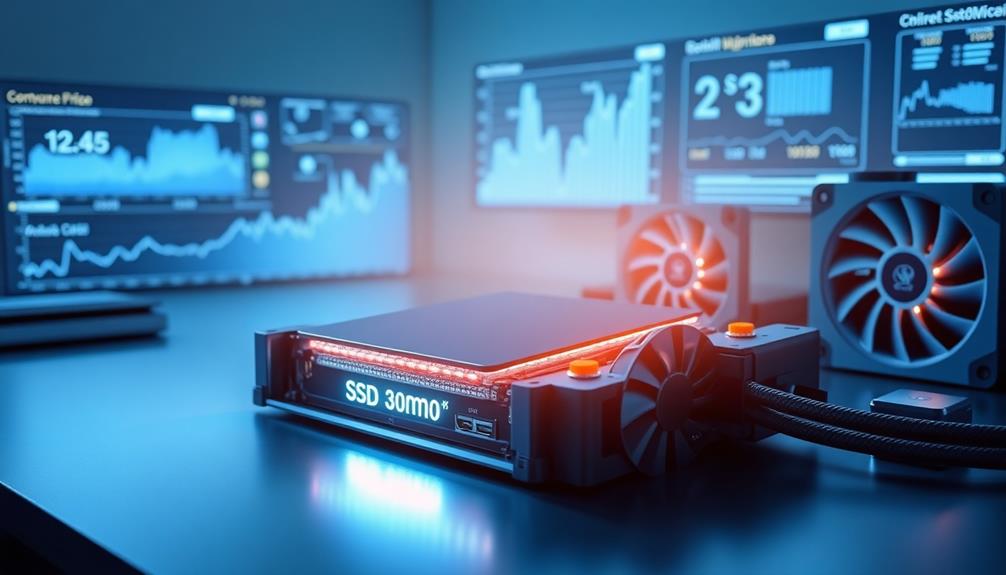
Managing heat is essential for getting the best performance from your SSD, especially during demanding tasks like audio processing. Effective heat management prevents throttling, guaranteeing your SSD operates seamlessly under heavy loads.
Here are some tips to optimize performance:
- Use Heatsinks: Adding heatsinks can greatly improve heat dissipation, particularly in desktop setups.
- Maintain Airflow: Verify your system has adequate airflow. Good ventilation helps keep temperatures down.
- Monitor Temperature: Regularly check your SSD temperatures using monitoring software. Keeping track can alert you to potential overheating issues.
- Consider Liquid Cooling: If you're serious about performance, explore liquid cooling options for your SSD. Though not widely available, they can further enhance heat management.
Community Insights and Resources

Engaging with online forums like Gearspace can really enhance your approach to SSD organization.
You'll find a wealth of performance tips and exclusive resources from industry experts that can help you optimize your setup.
Plus, sharing your own experiences can lead to valuable insights and connections within the community.
Engage With Online Forums
Participating in online forums like Gearspace can considerably enhance your understanding of pro audio gear and technology. Engaging with fellow enthusiasts and industry experts provides you with invaluable insights into optimizing SSD performance for sample streaming and managing your hard drives effectively.
Here are a few key benefits of joining these communities:
- Real-World Experience: Members share personal experiences with various SSD models, helping you make informed purchasing decisions.
- Performance Tips: Discussions often include valuable tips on maximizing SSD efficiency and organizing sample libraries.
- Expert Q&A: Many forums host exclusive Q&A sessions with industry professionals, giving you access to best practices for audio production and storage solutions.
- Collaborative Knowledge: Utilizing these resources fosters collaboration, enhancing your overall productivity and creativity in your audio production workflow.
Share Performance Tips
Sharing performance tips from community insights can greatly enhance your SSD's efficiency in audio production. Engaging with forums like Gearspace allows you to tap into valuable experiences and strategies regarding SSD performance, especially when working with orchestral libraries.
Many users emphasize the importance of optimizing both CPU and SSD settings to achieve peak performance in high-demand audio environments.
Utilizing benchmarking tools such as Crystal Disk is another smart move. These tools help you assess the speed and reliability of different SSD models, guiding your purchasing decisions effectively. By comparing performance metrics, you can guarantee your SSD can handle the demands of your audio projects.
Moreover, participating in exclusive Q&A sessions with industry experts can deepen your understanding of SSD performance maximization. These interactions often reveal insider tips that can greatly impact your workflow.
Lastly, staying updated on user experiences and recommendations can point you to reliable SSD brands and models tailored for your specific needs. By leveraging these community insights, you'll be well on your way to optimizing your SSD for seamless audio production and efficient orchestral library management.
Access Exclusive Resources
Community forums like Gearspace offer a treasure trove of insights and resources that can greatly elevate your audio production experience.
By engaging with fellow audio enthusiasts, you can tap into a wealth of shared experiences and expert advice. These communities are invaluable when it comes to optimizing SSD performance and managing cloud storage effectively.
Here are some benefits you can enjoy by participating:
- Access to performance tips tailored for audio workflows.
- Exclusive Q&A sessions with industry experts for troubleshooting.
- Benchmarking tools like Crystal Disk to assess SSD performance.
- Networking opportunities through community events and giveaways.
Managing Storage Capacity Effectively
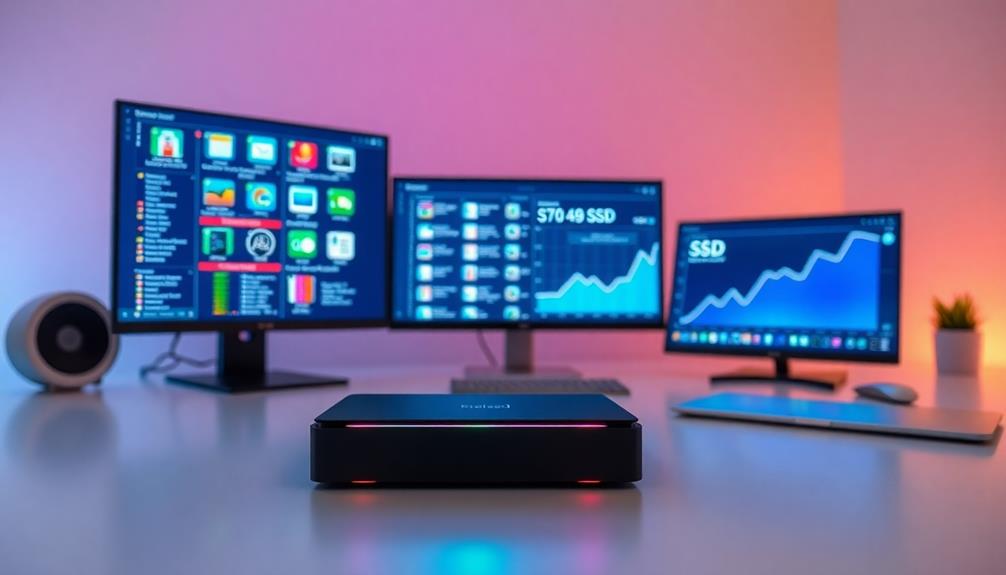
To manage storage capacity effectively, keep your SSDs under 85-90% full to guarantee peak performance and speed. When you exceed this limit, you'll notice slower access times and reduced efficiency, which can hinder your workflow.
For extensive sample libraries, consider investing in larger capacity SSDs, ranging from 1TB to several TB, to consolidate multiple smaller drives into a single, organized solution.
Regularly monitoring the available space on your SSDs is vital. Implementing compression techniques can optimize storage utilization, especially for audio projects where file sizes can quickly add up.
Remember, SSDs generally come at a higher cost per GB compared to traditional hard drives, so it's important to plan your storage strategy wisely.
A balanced approach involves utilizing multiple drives: SSDs for frequently accessed libraries and HDDs for less critical data. This way, you can maintain quick access to important files while managing overall storage capacity efficiently.
Recommended SSD Brands and Models
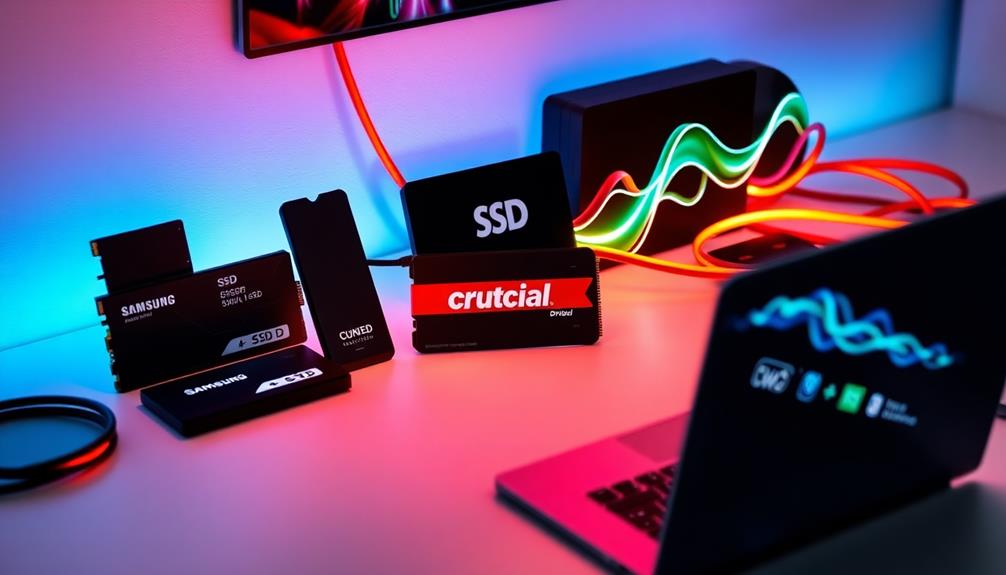
When you're looking for dependable SSDs, several brands stand out for their performance and reliability, particularly in audio production.
Choosing the right model can greatly impact your workflow, so it's vital to take into account a few key options.
- Vital MX500: Known for excellent value and performance, making it a favorite among audio professionals.
- Samsung 870 EVO: Renowned for its reliability and efficiency, especially in high-demand audio applications.
- WD SN750/SN770: These NVMe drives provide superior performance, enhancing sample loading times compared to cheaper SATA options.
- Samsung T7: A reliable external hard drive option, though internal drives may offer better speed and performance for many users.
While it's tempting to take into account budget models like the Vital BX500 or Samsung QVO, it's best to avoid them for long-term use due to reliability concerns.
Investing in these recommended SSD brands will help guarantee that your audio projects run smoothly and efficiently, allowing you to focus on what you love—creating great music.
Best Practices for File Organization
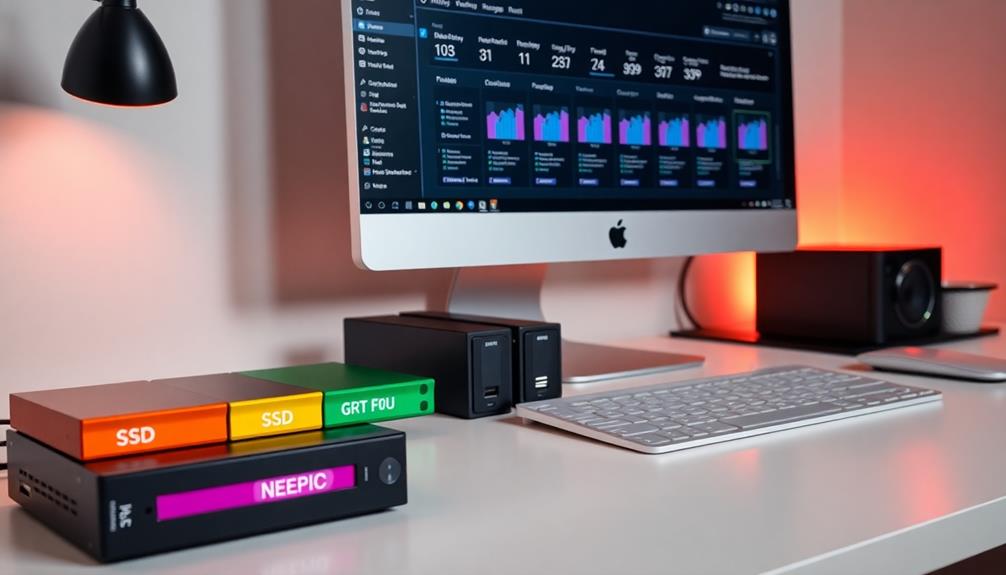
Effective file organization is essential for any audio professional, as it not only saves time but also enhances your creative workflow. Start by implementing a clear folder structure with a limited number of subfolders. This makes accessing samples and presets intuitive, allowing you to retrieve what you need quickly. Effective file organization is essential for any audio professional, as it not only saves time but also enhances your creative workflow. Start by implementing a clear folder structure with a limited number of subfolders. This makes accessing samples and presets intuitive, allowing you to retrieve what you need quickly. Naming files and folders consistently is another one of the most crucial efficient file management tips, as it prevents confusion during a project. Additionally, consider decluttering regularly by archiving older sessions, which keeps your workspace streamlined and focused on current projects.
Follow the 3 Click Rule to guarantee you can reach your files within three clicks from the main directory.
Store your presets in the plugin's native folder and categorize them by type—like bass, lead, or FX—to streamline your music production sessions. Regularly clean up unused files to maximize your hard disk space while maintaining a robust backup system to prevent data loss.
Creating a dedicated favorites folder for frequently used samples and presets can save you valuable time. Additionally, using a consistent naming convention will enhance identification and retrieval speed, making your workflow even more efficient.
Frequently Asked Questions
How Do You Organize Your Samples?
You can organize your samples by grouping them by company or pack name. Use a clear folder structure with three subfolders, and implement a consistent naming convention for easy identification and quick access during your workflow.
How Do I Maximize My SSD Speed?
To maximize your SSD speed, use M.2 NVMe drives, keep storage under 85% capacity, maintain a tidy folder structure, regularly clean up unused files, and manage heat effectively during intensive audio tasks.
What Not to Do With SSD?
Avoid filling your SSD like a packed suitcase; it won't open easily. Don't skip backups, use budget models, mix drive types, or ignore heat management. Keep it light, organized, and cool for peak performance!
How to Fix Slow SSD Speed?
To fix slow SSD speed, keep your drive under 85% capacity, update the firmware, run the TRIM command, disable unnecessary background processes, and consider upgrading to an NVMe SSD for faster performance.
Conclusion
By streamlining your SSD organization, optimizing performance, and managing storage, you'll release your creativity like never before. You'll access your samples with lightning speed, collaborate effortlessly, and produce high-quality music that resonates. Embrace the power of effective file management, invest in reliable SSDs, and watch your workflow transform. With these tips in hand, you'll not only enhance your music production but also enjoy a smoother, more efficient creative process. Let the music flow!

